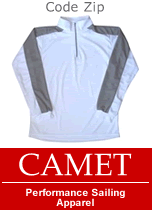

1/3rd scale testing, September 2006 undertaken in addition to two test sessions with 1/7th scale models in June and July 2006 for Mike Golding's Ecover 3.

Clay Oliver (left)co-designer of ECOVER 3 & Merf Owen (right) designer© Andi Robertson
American Clay Oliver has been a principal on the design team at Team New Zealand since 1995 and has been involved in six America’s Cup including four winners. He was involved with Merf Owen on the design of ECOVER 2, and worked as part of the design team on the record breaking Mari Cha IV. Since May 2003 Owen Clarke have worked closely with Clay. Here, Clay describes his work on the new ECOVER 3:
"During this project I was also working mostly on the America’s Cup at the time and so I helped on the conceptual design, the lines development and the tank testing and some VPP analysis."
"One of the interesting things was using a larger, one seventh scale model, a boat actually at Lyngby, north of Copenhagen.
It was quite interesting dealing with a boat in the tank, so we were dealing with higher accuracy, and at the same time with higher loads with all the appendages that we were working with. We had an interesting time trying to keep it all hanging together, the challenge with the model at the Wolfson Unit as well."
"The Wolfson Unit had been looking at it for some time as somewhere to do large scale tank testing. It is a wonderful tank though of course logistically we had to then load the models on the car and drive it there across to Denmark.
"Essentially with the small scale models you are looking at the sizing of the boat and the shape, at the tank here in the University of Solent. I think we did about seven models at that scale. Part of this is that we had been doing tank testing for other yachts as well, so in a way there is an experience base as well. From that we decided on the hull, built the large model and went to Denmark."
" Usually we are trying to decide things like beam, and the performance across a mix of races that you are thinking about, whether it is two handed, single-handed around the world, then once you have decided on the beam, and then you start thinking about smaller hull shape changes and appendages, what kind of appendage configurations you might have."
"Hopefully if we have done everything right then when we get to the large model, then in the way things then you sometimes put a small tweak in in the end. Most boats that have gone into the water after the tank have had some small tweak at the end, after testing."
"It is very similar to the Cup with the tank testing, but with the Cup usually you will be testing a lot more models, because you can, and because you are running much smaller variations. Usually running two programmes: one, the so called conceptional or revolutionary and the evolutionary. Conceptually you do the same thing here, running what are maybe the big ideas, the new ideas, and then maybe you do it on paper, if that is a good idea, then try it on the models."
"Basically this boat is more powerful, provides a greater demands on the sailor, in terms of skill and experience, greater attention to reliability, because there is increased stability sail shapes can be different, so there can be progressions and developments in terms of sail design and sail shapes. But the general theme is that the loads are larger, the boats are more powerful, the boats will be going faster.
More experienced sailors will be benefiting from trying to make the right choices because it will be very demanding on their resources." - http://www.mikegolding.com/
"During this project I was also working mostly on the America’s Cup at the time and so I helped on the conceptual design, the lines development and the tank testing and some VPP analysis."
"One of the interesting things was using a larger, one seventh scale model, a boat actually at Lyngby, north of Copenhagen.
It was quite interesting dealing with a boat in the tank, so we were dealing with higher accuracy, and at the same time with higher loads with all the appendages that we were working with. We had an interesting time trying to keep it all hanging together, the challenge with the model at the Wolfson Unit as well."
"The Wolfson Unit had been looking at it for some time as somewhere to do large scale tank testing. It is a wonderful tank though of course logistically we had to then load the models on the car and drive it there across to Denmark.
"Essentially with the small scale models you are looking at the sizing of the boat and the shape, at the tank here in the University of Solent. I think we did about seven models at that scale. Part of this is that we had been doing tank testing for other yachts as well, so in a way there is an experience base as well. From that we decided on the hull, built the large model and went to Denmark."
" Usually we are trying to decide things like beam, and the performance across a mix of races that you are thinking about, whether it is two handed, single-handed around the world, then once you have decided on the beam, and then you start thinking about smaller hull shape changes and appendages, what kind of appendage configurations you might have."
"Hopefully if we have done everything right then when we get to the large model, then in the way things then you sometimes put a small tweak in in the end. Most boats that have gone into the water after the tank have had some small tweak at the end, after testing."
"It is very similar to the Cup with the tank testing, but with the Cup usually you will be testing a lot more models, because you can, and because you are running much smaller variations. Usually running two programmes: one, the so called conceptional or revolutionary and the evolutionary. Conceptually you do the same thing here, running what are maybe the big ideas, the new ideas, and then maybe you do it on paper, if that is a good idea, then try it on the models."
"Basically this boat is more powerful, provides a greater demands on the sailor, in terms of skill and experience, greater attention to reliability, because there is increased stability sail shapes can be different, so there can be progressions and developments in terms of sail design and sail shapes. But the general theme is that the loads are larger, the boats are more powerful, the boats will be going faster.
More experienced sailors will be benefiting from trying to make the right choices because it will be very demanding on their resources." - http://www.mikegolding.com/







